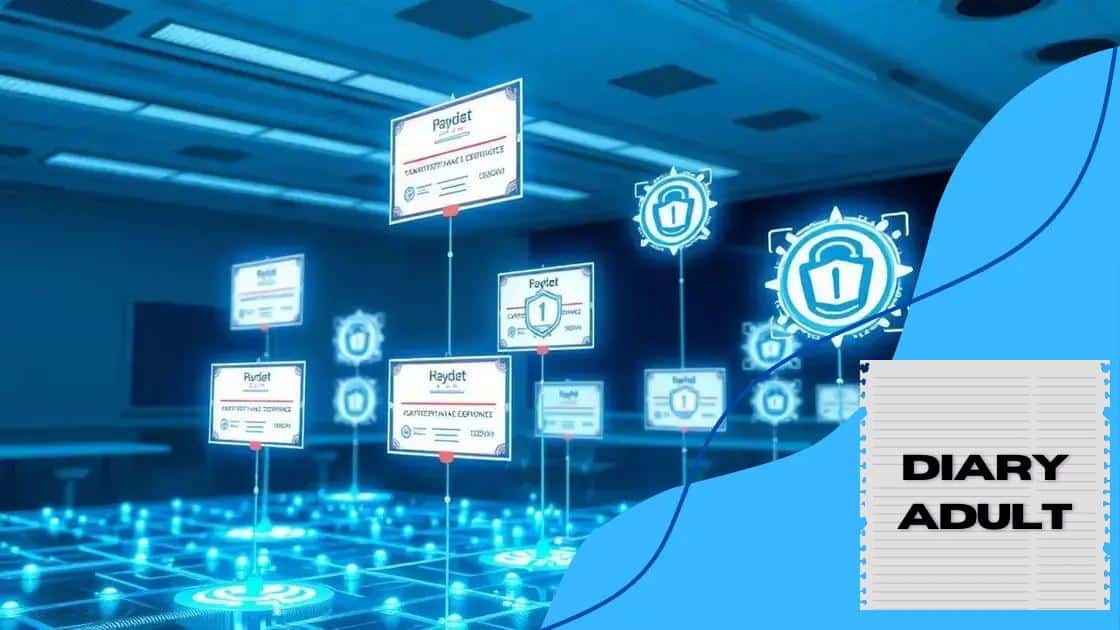Blockchain for validating academic credentials and achievements

Blockchain for validating academic credentials enhances security, efficiency, and accessibility, transforming how educational achievements are verified while addressing challenges such as costs and data privacy concerns.
Blockchain for validating academic credentials and achievements is changing how we perceive educational verification. Have you ever wondered how secure your diploma really is? Let’s dive in.
Understanding blockchain technology
Understanding blockchain technology is key to grasping how it can transform academic credential verification. At its core, blockchain is a decentralized digital ledger that securely records transactions across many computers. This means that once information is entered, it cannot be altered without consensus from the network, making it incredibly reliable.
Many people think of blockchain as just the technology behind cryptocurrencies like Bitcoin. However, its potential extends far beyond that. The unique properties of blockchain ensure transparency, traceability, and security in various applications, especially in education.
Core Features of Blockchain
There are three main characteristics that make blockchain appealing for validating academic credentials:
- Decentralization: Unlike traditional systems, where a single central authority has control, in blockchain, data is distributed across several nodes, reducing the risk of corruption or misuse.
- Immutability: Once data is recorded on the blockchain, it is nearly impossible to alter. This ensures that academic records remain trustworthy and can be verified without doubt.
- Transparency: Everyone with access to the network can view the records, allowing for easy verification of degrees and other credentials without the need for intermediaries.
Moreover, the ability to access academic records through a blockchain can streamline the verification process. This means that employers can quickly confirm a candidate’s qualifications, making the hiring process more efficient. Imagine a world where diplomas and certificates can be checked with a simple mouse click, leading to less fraud and more trust in the hiring process.
How Blockchain Works
To understand how blockchain functions, it’s essential to know about its structure. Each “block” in the blockchain contains a number of transactions. Once a block is filled, it is linked to the previous block, forming a chronological chain. This structure not only helps to keep data organized but also secures it against cyber threats.
As thousands of transactions occur simultaneously, the network runs complex algorithms to validate the information being added. This process, called consensus, keeps the network synchronized. Whenever a new academic credential is added, it undergoes this rigorous validation, ensuring its authenticity.
Thus, integrating blockchain into credential verification offers a revolutionary solution. It enhances security, reduces fraud, and builds trust in academic achievements while simplifying the verification for employers and institutions alike.
How blockchain secures academic records
How blockchain secures academic records is a vital topic for understanding the potential of this technology in education. With increasing concerns about fraud, traditional methods of storing academic credentials are becoming obsolete. Blockchain offers a revolutionary way to ensure that records are not only secure but also easily verifiable.
The technology works by creating a decentralized network where information about academic achievements is stored. Each piece of data is linked to previous entries in an immutable chain. This means that once a degree is recorded, it cannot be changed or deleted without a consensus from the network. As a result, institutions can confidently issue diplomas and certificates that are trustworthy and resistant to fraud.
Features of Blockchain Security
One of the main benefits of blockchain for securing academic records is its use of cryptography. Each transaction on the blockchain is encrypted, which adds a layer of protection against unauthorized access. Additionally, because the data is distributed across many nodes, it is less vulnerable to attacks compared to centralized databases. This decentralization makes it challenging for hackers to modify records without being detected.
- Transparency: Blockchain allows for transparent tracking of academic achievements. Anyone authorized can see the entire history of a record without compromising sensitive information.
- Auditability: With blockchain, every change made to academic records is logged. This means that institutions can always verify the authenticity and integrity of their credentials.
- Trustworthiness: As academic records become more secure, employers can trust that the qualifications listed by candidates are legitimate.
Furthermore, using blockchain technology means that institutions can easily update records when necessary. For example, if a student completes additional coursework, that information can be added to their blockchain record seamlessly. This ensures that all achievements are reflected accurately and in real-time.
As we explore the implications of blockchain technology in education, it becomes clear that securing academic records is not just beneficial; it’s essential for building a future with integrity and trust. Through increased security and accessibility, blockchain paves the way for a transparent approach to credential verification.
Benefits of using blockchain in education

Benefits of using blockchain in education are significant and wide-ranging. As educational institutions search for better ways to manage and verify credentials, blockchain serves as a game-changer. It streamlines processes and enhances trust in the systems we rely on.
One of the most notable advantages of blockchain technology is its security. By providing a decentralized record-keeping system, institutions can safeguard academic achievements against tampering and fraud. This ensures that when students graduate and receive their diplomas, those records are both authentic and verifiable.
Efficiency and Cost-Effectiveness
In addition to security, blockchain improves efficiency. Traditional methods of verifying academic credentials often involve lengthy processes, requiring multiple phone calls or emails. With blockchain, verification can happen almost instantly. This speed not only saves time but also reduces operational costs associated with administrative tasks.
- Time savings: Instantaneous verification reduces delays in hiring or further education.
- Lower administrative costs: Streamlined processes mean less time spent on manual verification.
- Improved accuracy: Automated systems minimize human error during verification.
Another benefit is enhanced transparency. Blockchain allows all stakeholders—including students, employers, and educational institutions—to access the same records. This shared access creates a more trustworthy environment. Employers can easily confirm that candidates have the qualifications they claim, reducing the chances of hiring fraud.
Moreover, students benefit from having their achievements digitally stored on the blockchain. They can share their records with potential employers or other institutions securely and conveniently. Imagine being able to present your verified educational achievements to employers worldwide at the click of a button.
As educational systems evolve, blockchain can also support lifelong learning. It allows individuals to update their records as they acquire new skills or credentials. This flexibility means that education can continuously adapt to the changing job market, providing learners with more relevant qualifications as they progress in their careers.
Challenges and considerations with blockchain
Challenges and considerations with blockchain are essential to discuss when exploring its implementation in education. While the benefits are significant, there are several hurdles to overcome for successful integration.
One primary challenge is the cost of implementation. Setting up a blockchain system can be expensive for educational institutions. This includes investments in technology, staff training, and ongoing maintenance. Institutions must weigh these costs against the potential benefits they will gain in transparency and efficiency.
Data Privacy Concerns
Another concern is data privacy. While blockchain is known for its security, the fact remains that educational records can contain sensitive personal information. Institutions need to ensure that they comply with regulations like the Family Educational Rights and Privacy Act (FERPA) in the U.S. and similar laws globally. Balancing transparency with privacy is a critical consideration.
- Data ownership: Who owns the data on the blockchain? This is a complex question that requires clear policies.
- Regulatory compliance: Institutions must adhere to laws governing data protection while implementing blockchain.
- Public vs. private blockchain: Deciding whether to use a public or private blockchain impacts privacy and access.
Another challenge is the need for standardization in the way blockchain is implemented across different educational institutions. Without common standards, it becomes difficult for employers and institutions to interpret and validate blockchain credentials properly. This can lead to confusion and ineffective verification processes.
Moreover, there is a trust barrier among some educational institutions and employers regarding the new technology. Many may be unaware of how blockchain works or its benefits, creating hesitance in adoption. Without widespread acceptance, the full potential of blockchain cannot be realized.
To address these challenges, educational institutions must invest in education about blockchain technology. Providing training for staff and clarification of the technology’s benefits can help build trust and acceptance. Engaging with stakeholders, including employers, can also facilitate a smoother transition to blockchain solutions.
Future of credential validation with blockchain
The future of credential validation with blockchain is exciting and full of potential. As technology continues to evolve, the way we verify academic achievements will undergo significant changes. Blockchain can lead to an era of greater transparency, trust, and efficiency in education.
One major aspect of the future is the increased adoption of blockchain technology in educational institutions. As more schools and universities implement blockchain systems, the process of validating credentials will become standardized. This standardization will help create a more robust framework for both institutions and employers.
Global Accessibility
Additionally, blockchain can enable global accessibility to credentials. Students will have the ability to store their achievements securely on a decentralized platform. This allows them to present their educational records to potential employers anywhere in the world with ease. No more long waits for verification or fear that documents may be lost in transit.
- Decentralized records: Students can own their data and share it when needed.
- Instant verification: Employers can quickly access verified credentials.
- Wider reach: Graduates can apply for jobs internationally without credential verification delays.
Furthermore, the future could see the emergence of smart contracts used in conjunction with blockchain. Smart contracts are self-executing contracts with the terms of the agreement directly written into code. This means that once certain conditions are met, such as a student completing their degree, their credentials could automatically be issued and verified without any human intervention. This automation could save time and reduce the risk of errors.
There may also be innovations in how credentials are represented digitally. Instead of traditional paper diplomas, we might see digital badges or certificates that can be easily displayed on social media or professional networks like LinkedIn. These digital credentials can include links to the blockchain verification, providing instant proof of achievements.
As the technology matures, it’s likely that integration with other emerging technologies will occur. For instance, combining blockchain with artificial intelligence could further enhance the credential verification process, allowing for better data analysis and fraud detection. The future is not just about blockchain alone; it’s about how it can work alongside other technologies to create better educational outcomes.
FAQ – Frequently Asked Questions about Blockchain in Education
What is blockchain technology?
Blockchain is a decentralized digital ledger that securely records information across many computers, making it virtually impossible to alter without consensus.
How does blockchain improve credential verification?
It allows for instant verification of academic credentials, reducing the time and effort needed for traditional verification processes.
What are the main benefits of using blockchain in education?
Key benefits include enhanced security, increased efficiency, and global accessibility for verifying credentials.
What challenges does blockchain face in education?
Challenges include high implementation costs, data privacy concerns, and the need for standardization across institutions.





